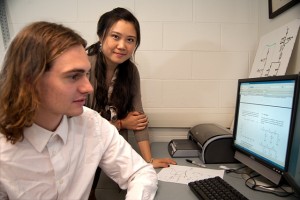
Felix Hutchison ’12 and Yue (Luna) Yuan ’12
What if the breakthrough treatment for Alzheimer’s disease isn’t in a pill but in a computer? What if a paralysis victim could operate an electronic device just using the power of the mind?
These are questions that Yue “Luna” Yuan ’12 (Wuhan, China), a mechanical engineering and policy studies dual major, and Felix Hutchison ’12 (Plainsboro, N.J.), an electrical & computer engineering and mathematics double major, are tackling through the Grand Challenges Scholars Program. In 2008, the National Academy of Engineering identified 14 Grand Challenges for Engineering in the 21st century, one of which is to “reverse engineer the brain.” Yih-Choung Yu, associate professor of electrical and computer programming, serves as their faculty adviser.
Three other Lafayette groups also were selected to receive support through the program, including Emily Melvin ’12 (Seaford, N.Y.); Jared Katz ’12 (Stoneham, Mass.) and Katherine Metcalf ’12 (Springfield, Va.); and Thomas Benjamin ’12 (Norristown, Pa.) and Elliott Mitchell-Colgan ’12 (Henderson, Nev.). Beginning their projects this summer, they will complete them in their senior year. Through a gift from a Lafayette alum, each student receives $3,000 in summer research stipends in addition to a $3,000 budget for project expenses, on-campus summer housing, and $1,000 to participate in the Grand Challenges Scholars Program National Summit during their senior year.
Read about Grand Challenges projects
The Grand Challenges approach at Lafayette is unique in that the students must take an interdisciplinary approach to solving their problems, combining engineering with the liberal arts. Yuan and Hutchison knew from the start that their project has implications far beyond engineering’s boundaries. Together, they’re simulating neurons by building electrical circuits in computer software. While neurons, the electrically active cells in the brain and nervous system, are well understood, their operation in certain structures is more difficult to sort out.
“This is a fascinating field that could potentially become the most important technological breakthrough in decades,” says Yuan. “Our model could help us understand how neurons operate in certain structures, and applications of it could contribute to artificial intelligence and enhance human abilities.”
The team devised a mathematical solution to describe the neuron’s electrical output and then generated a circuit to produce the output, or act as the axon. The surrounding circuitry acts as the neuron body, with the complete model mimicking a neuron’s electrical behavior. Creating artificial neurons has a wide array of practical applications, such as Brain Computer Interface (BCI), a direct communication pathway between the brain and an external device.
“BCIs are often aimed at assisting, augmenting, or repairing human cognitive or sensory-motor functions,” explains Yuan. “With sub-neural implants, it becomes possible to directly transmit data from the brain to an electronic device. This technology would allow one to control electronic devices using only cognitive strength, an incredible boon to victims of paralysis.”
If the team can accurately simulate neurons and build the artificial neurons at a small enough scale to replace damaged neuron networks inside the brain, it could also impact the treatment of Alzheimer’s disease.
Applying technology to medicine always includes a murky gray area, which is where Yuan’s policy studies background comes into play. Because their small-scale model does not yet have direct applications, ethics aren’t an immediate concern, but the team must take them into account as the project grows. Grand Challenges is the perfect training ground for Yuan, who plans to pursue a master’s degree in technology and policy.
Originally a neuroscience major, Yuan switched to mechanical engineering after taking some introductory courses but always remained interested in the way the brain works. The interdisciplinary approach of Grand Challenges allows Yuan and Hutchison to approach a complex problem from all angles – something necessary if their model is ever to be applied directly.
“As an engineer, I’m interested in solving problems. It’s important to not just be a learner, but a doer who can apply the knowledge,” says Yuan. “But I realize that technology alone can’t solve some of the most critical problems in the world. Technology needs humanity to go hand-in-hand, and the latter is done through proper policy guidance. We need experts who can communicate between the engineering world and policy world with a well-rounded background and interdisciplinary approach to solve complicated problems.”

2 Comments
Comments are closed.